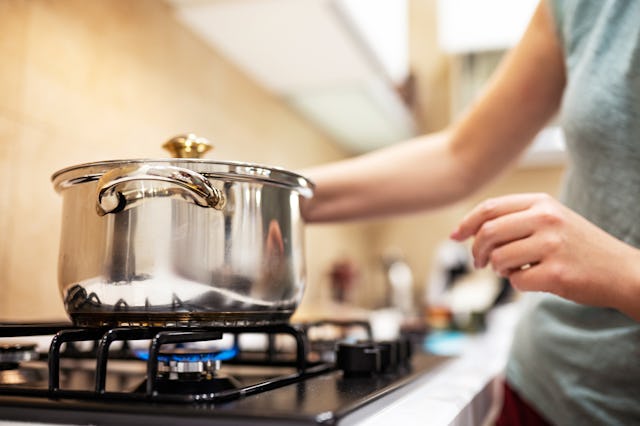Researchers Are Ripping The Gas Stoves Out Of Their Houses For Their Kids’ Health
Numerous studies have shown that gas stoves have an alarming effect on their health.

For years, gas stoves have been seen as the optimal choice for serious cooks and high-end kitchens — but an alarming number of studies have found that these appliances pollute our household air to an extent that it can harm our kids’ heath, not to mention the earth.
The concerns about gas stoves have become such a topic of conversation that some are calling for a federal gas stove ban. New York already became the first state in the country to ban natural gas and other fossil fuels in most new buildings.
In fact, many of the scientists conducting these studies have been so stunned by the results that they’re ripping the gas stoves out of their own homes despite the cost of replacement.
What are the dangers of owning a gas stove?
Rob Jackson, a professor of environmental sciences at Stanford University, recently conducted a study that found that gas stoves constantly leak a little methane, even when turned off, and pollute household air with nitrogen oxides, and other dangerous gases, which can damage lungs, especially kids’ lungs.
Jackson’s gas stove has an electric oven but he can’t just replace the gas half. Still, he’s getting a replacement.
“I am reluctant to throw away a perfectly good electric oven,” he told CBC earlier this month. “But we’re going to do that.”
It’s the same for Tara Kahan, a University of Saskatchewan chemist who conducted a study in 2018 where she and her colleagues took air readings in homes using gas stoves. Kahan and her fellow researchers found shockingly high amounts of nitrous oxide in the air after cooking sessions — and the toxins didn’t recede for several hours.
“All of the researchers were pretty horrified,” she also told CBC. The levels exceeded Health Canada guidelines for one-hour exposure — and the fumes lasted for longer than that.
“After that, as soon as it was feasible, I switched from a gas stove to [electric] induction,” she added.
University of Colorado environmental engineer Shelly Miller is also foregoing the gas stove.
“Cooking,” she told Mother Jones in 2021, “is the No. 1 way you’re polluting your home. It is causing respiratory and cardiovascular health problems; it can exacerbate flu and asthma and chronic obstructive pulmonary disease in children. You’re basically living in this toxic soup.”
The negative effects of gas stoves
Very simply, burning natural gas produces toxins like nitrous oxides, carbon dioxide, and formaldehyde, which in turn have a significant affect on our health when we breath them in, even in small doses that we don’t notice at all.
In a meta analysis of 41 studies on the subject, published in the International Journal of Epidemiology in 2013, researchers found that kids living in homes with gas stoves has a 42% increase in current asthma; an increase of a kid’s risk of lifetime asthma and wheezing is also attributed to gas stoves. Other studies have linked gas cooking to increased lung issues in children as well as anyone, including adults, with chronic obstructive pulmonary disease.
A 2014 study by the Lawrence Berkeley National Laboratory found that cooking with gas for one hour without using your hood adds up to 3,000 parts per billion of carbon monoxide to the air — raising indoor concentrations by up to 30%.
These studies also find that newer ranges don’t produce any less pollution than older models.
Gas stoves release the greenhouse gas methane into the air — and emissions from U.S. gas stoves alone each year equals emissions from a half-million cars.
The studies have been so conclusively worrying that some U.S. cities are taking action, with New York and the Bay Area (San Francisco, San Jose, Berkley, and Oakland) taking the lead. In these metro areas, gas stoves will be banned in new constructions — New York’s ban begins in 2023, and bans in 39 smaller California cities, including the Bay Area cities mentioned, are already in effect.
What to do if you have a gas stove
While many researchers recommend replacing your home’s gas stoves — it stands that many millions of people don’t have the ways or means to toss their gas appliances. Some might not have the money and others might rent. In these cases, there are several things you can do to reduce the amount of air pollution that your stove creates when you cook.
Jackson recommends always using your accompanying hood ventilation — studies show that most people don’t always use it because of the noise, but it’s worth it. You should also check to see where your hood ventilates to, as some filter the air but don’t force it outside — simply circulating the polluted air around your home. All in all, hood ventilators cuts your stove’s air pollution about in half if they’re working right.
Besides that, you can also open windows if the weather allows or use HEPA air filters in your home. Or — try alternate methods of cooking more often.
Another helpful tip if you’re stuck cooking with gas? If you use your back burners, your hood will catch more of the pollutants.
Ellen Smit, a researcher from Oregon State University who in 2014 found that gas stoves exacerbate asthma, asthma symptoms, and chronic bronchitis in kids said it most simply: “Parents of all children should use ventilation while using a gas stove.”
That’s if you can’t find a way to get rid of yours.
This article was originally published on